Your Furnace Filter: What It Is and How It Works

Your furnace filter is the unsung hero of your furnace. It quietly does its job without any fuss and allows the rest of the furnace to do its job. It’s not a complicated item, but there are things you need to know about it to allow it to correctly do its job.
Its Purpose
The main purpose of your furnace filter is to protect your furnace, specifically the blower fan, from all the dust, debris, hair, and other pollutants the return duct takes in. The filter also aids in your home’s IAQ (indoor air quality) for your breathing health.
How It Works
Your furnace cycles air through your Athens, OH, home, ducts, and furnace. The cold air is drawn through the system’s return ducts to the furnace, where the air is heated through the heat exchanger. The now-heated air travels through the ducts out through the vents into your home’s rooms. The warmer air, now in your rooms, pushes the existing cold air back through the return ducts, and the process begins again. With all this air traveling and pushing, it’s picking up the dirt, dust, and other pollutants to travel along with it. This all passes through your furnace’s filter, and the filter prevents it from getting to the rest of the system and being pushed into your rooms.
Types and Sizes
Types
There are several types of furnace filters on the market. It can be confusing, so ask one of our Airclaws HVAC technicians which filter type would work best for your home and situation. The most common types are:
Sizes
Just as there are different types of filters, there are different sizes as well. The size is pretty much dictated by your furnace. If you’ve noticed the measurements on your filter’s box, you’ll see it’s sized by thickness/depth, height, and length. The most common thickness is 1” and second runner up is the 4”. Common sizes range from 14” x 25” to 25” x 25”. Check your manufacturer’s instructions to determine your furnace’s recommended filter size, or, if you already have a filter, check the filter’s frame for the size printed or written there.
MERV Ratings
Filters are rated on their denseness, in terms of their Minimum Efficiency Reporting Value, or MERV. Most filters’ values range from 1 to 16, with the higher number representing the thickest and densest filter. While a filter with a higher MERV rating will most definitely catch more dust and pollutants, it can be so thick that it impedes your furnace’s airflow, which can lead to a whole other hosts of issues. It’s best to check with an HVAC technician to determine the appropriate MERV value you should use with your furnace.
Changing/Replacing It
Your furnace filter needs to replaced or cleaned on a regular basis for optimum furnace maintenance, as well as for your optimum lung health. Depending on the type of filter your furnace uses, you may need to change or clean the filter monthly or every three months at maximum. With a permanent type of filter, you may need to clean it monthly and only replace it after years of use. Since this affects the health of both your furnace and yourself, it’s best to err on the side of caution. Check your filter monthly, and if it looks dirty, replace or clean it. Those with breathing issues should definitely abide by this recommendation.
Your furnace filter is responsible for more than most people know, and its condition directly affects both your HVAC system as well as your lungs. It’s important to regularly take care of its maintenance to keep everything working well. Be sure to contact our Airclaws professionals at 740-448-7278 with any questions you may have about your HVAC system, especially your filter.
Contact the experts!
